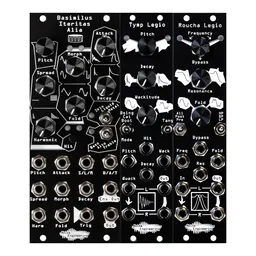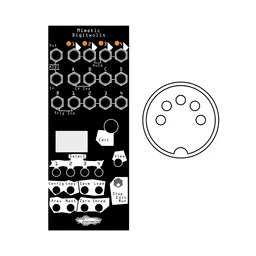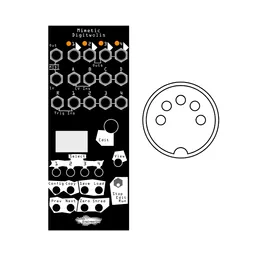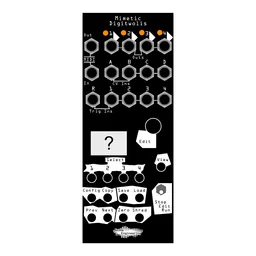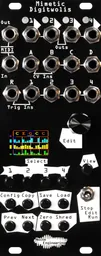Last week, we created a basic sequence with Mimetic Digitwolis. This week, we’re exploring some randomization and destructive edits that can be controlled by external signals, and how you can use them to create a generative system that evolves over time.
Shred
The Shred randomize trigger is the most immediate way to change a sequence. Shred randomizes a step within the minimum and maximum note/voltage settings of the lane, and respects the scale of Note lanes as well. Shred can be triggered manually from the front panel, but can also be mapped to a trigger input with the Sequence: Shrd parameter. Shred mappings are assignable per lane, so you can pick and choose what gets randomized – and what doesn’t!
One of my favorite ways to create evolving sequences is to set the sequence length to an odd number like 3 or 5, then patch a /8 clock signal to the Shred mapping. This changes one step of the sequence every couple of cycles, creating a slow evolution that will slowly but drastically change over time.
Alternatively, run a copy of your advance clock through a probability processor like Jam Jam, then patch the result into the Shred mapping. Set the probability to a low setting, and steps will have a random chance of being randomized!
Zero
The Sequencer: Zero mapping resets the current step to the minimum setting when it’s triggered. It’s the antithesis of Shred, and I like patching it in a similar way. Building on the first patch above, I like running a /64 or other very slow clock trigger to Zero when using a Shred-based patch. This will ensure that the root note in the lowest octave is played at regular intervals, even if the rest of the notes in between become completely randomized.
Shift
Sequence: Shft, and its partner parameter Amt, move the entire sequence back when triggered. Shft sets the trigger mapping, and Amt sets the amount of steps the sequence will shift.
I really like using Shift on preprogrammed sequences. Use a slow divider, and as your sequence places, it will change its starting point at a set frequency.
Random
The Step: Rand mapping will jump to a random step in the sequence. This is the only non-destructive parameter covered here, so if you have a sequence you really like but want to spice it up a bit, having the occasional random jump can be a great way to do that. Since Rand can be mapped along with advance and reset triggers, you can occasionally randomize then go right back to the beginning with occasional random triggers and steady clock inputs.
In addition to mixing up a sequence, I like using the Rand mapping to randomly output one of a few preset voltages. Set the sequence length to something low (I often use 3 or 4), tune your steps to preset intervals or modulation CV that you like, and you’ll generate curated random voltages every time Rand is triggered!
That’s so random
With the tools we’ve explored in this post, you can create generative systems as simple or as complex as your heart desires. Simple shred mappings are a great way to spice up a CV or note sequence, and Zero and Shift mappings allow for complex systems that evolve over time. In the next posts in this series, we’ll cover a few ways you can connect and integrate Mimetic Digitwolis with the other gear in your studio.
